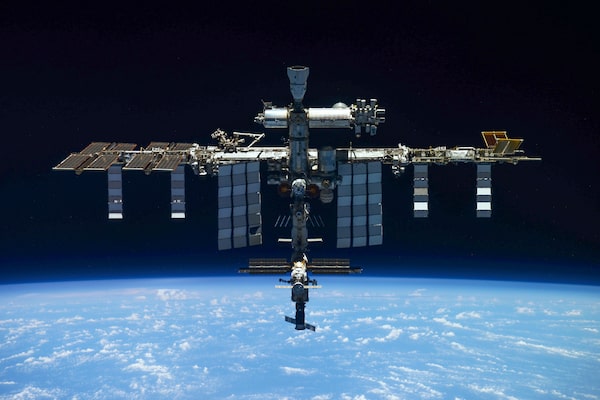
The International Space Station on March 30.The Associated Press
Michael Byers holds the Canada Research Chair in Global Politics and International Law. Aaron Boley holds the Canada Research Chair in Planetary Astronomy. They teach at the University of British Columbia and co-direct the Outer Space Institute.
Russian threats to leave the International Space Station are frequent, predictable – and at this point, almost empty.
On Tuesday, the new head of Russia’s space agency, Yuri Borisov, continued this tradition by saying: “Of course, we will fulfill all our obligations to our partners, but the decision about withdrawing from the station after 2024 has been made.”
The resulting media storm was a tempest in a teapot. Russia continues to co-operate with Western nations on the ISS, and Mr. Borisov, who chose his words carefully, said the withdrawal would be “after 2024.”
A day later, the Russian space agency Roscosmos informed NASA that the planned withdrawal date was, in fact, 2028. This was consistent with a recent agreement that will see two cosmonauts fly to the ISS on SpaceX’s Crew Dragon spacecraft, in return for two American astronauts flying on Soyuz.
Since the ISS is two decades old, both Russians and Americans are surely thinking about next steps. NASA foresees private companies operating space stations around 2030, enabling the agency to focus on more distant and difficult missions.
Russia tells NASA it is staying on International Space Station until at least 2028
Russian officials, meanwhile, talk about building their own space station. But while the Soviet Union did just that, it is doubtful that Russia – weakened by cronyism, corruption, foreign engagements and economic decline – could replicate the feat, at least on as short a timeline as 2028. (Russia could work with China, though the orbit of its still-under-construction Tiangong space station is angled in such a way that impedes access to it from cosmodromes in Russia and Kazakhstan.)
Continued co-operation with Western nations on the ISS is Russia’s best – and perhaps only – option for keeping its space program alive. The Russian government appears to know this, which is comforting.
Much less comforting, however, is that Russia recently engaged in a rash act that signals a possible willingness to terminate its space program as we know it, in order to extend armed conflict to space.
Last November, Russia tested a ground-based missile against a defunct Soviet-era satellite, blasting it into thousands of pieces of space debris. The debris immediately put hundreds of satellites from the United States, Europe, Canada, and Russia at risk, as well as the ISS.
Today, those pieces are forcing satellite companies to conduct frequent collision avoidance manoeuvres, consuming precious thruster fuel. If some of the pieces do collide with satellites or other space objects, even more debris will be generated, amplifying the risks.
Russia, in short, has already demonstrated a willingness to accept the possible loss of its own satellites – and perhaps even its cosmonauts – in order to demonstrate its space-combat capabilities to others.
Worse still, it is at least possible that Russia is now considering whether to target foreign satellites that are providing high-quality satellite imagery to Ukraine. Some of these satellites are Canadian and use “synthetic aperture radar” (SAR) that can “see” at night and through clouds.
Three of the satellites – collectively called Radarsat Constellation – belong to the Canadian Armed Forces. A fourth, RadarSat-2, is owned by MDA, the same company that made the Canadarm. Images from these satellites are useful for civilian purposes such as monitoring Arctic sea ice, but they’re also well-suited for tracking troop movements, down to the level of identifying the location of individual tanks and artillery pieces.
Usually, satellite companies do not publicize the provision of imagery to military customers. But in March, after Ukraine’s minister of digital transformation appealed for imagery from Western companies, MDA stepped up. “Images captured by MDA’s SAR technology, which is unique for its ability to see through all weather and cloud conditions, will be merged and analyzed with other sources of imagery from commercial Earth observation companies to develop comprehensive near real-time intelligence reports for Ukrainian government officials,” MDA CEO Mike Greenley announced at the time.
Shunning of Russia strains International Space Station partnership
The move, which was authorized by the Canadian government, was admirable. But it was not without risks. If Russia decides to extend its war in Ukraine into space, Radarsat-2 will be at the top of its target list.
One cannot assume that Russia would necessarily hold back from striking a Canadian satellite. It has already deployed a number of “non-kinetic” weapons against U.S. satellite companies, including an alleged cyberattack against ViaSat and efforts to jam signals from SpaceX satellites.
Russia might even argue that Radarsat-2 is a legitimate target under the law of armed conflict, the rules that apply after a conflict has begun. Even though the Russian invasion itself is illegal under the UN Charter, the law of armed conflict applies equally to all participants and governs the conduct of the hostilities.
For a target to be legal, three criteria must be met. First, the object must be making an effective contribution to military action; second, striking the target must be militarily necessary; and third, the strike must not cause suffering or injury to civilians that is excessive to the concrete and direct overall military advantage anticipated.
The third criterion poses problems for Russia. A strike against RadarSat-2 would create a vast amount of space debris, which could strike satellites that support essential civilian purposes such agriculture and disaster relief.
The good news is, as long as cosmonauts remain on the ISS, Western satellites are probably safe from Russian missiles.
International co-operation in space matters. If it stops, all bets are off.
Keep your Opinions sharp and informed. Get the Opinion newsletter. Sign up today.